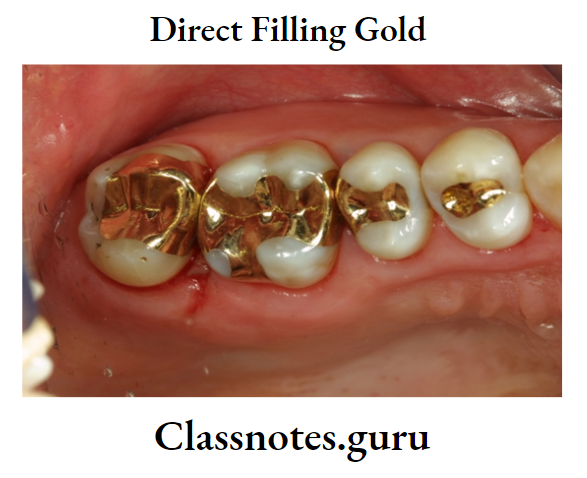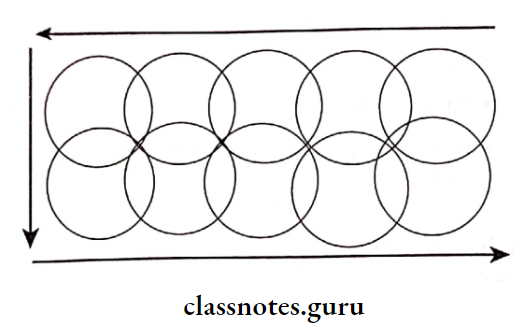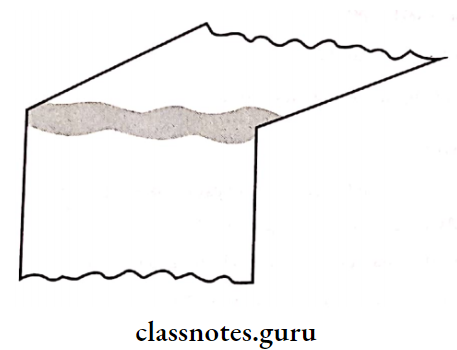Direct Filling Gold Short Essays
Question 1. DFG (Direct Filling Gold).
Answer:
DFG (Direct Filling Gold):
Direct Filling Gold Definition:
- Direct gold is a gold restorative material that is manufactured for compaction directly into prepared cavities
Direct Filling Gold Indications:
- Class 1 cavities Small carious lesions in pit and fissures of posterior teeth
- Class 5 carious lesions
- Class 3 cavities proximal surfaces of anterior teeth
- Class 2 restoration of small cavitated proximal surfaces of posterior teeth
- Class 6 Incisal edges or cusp tips
- A defective margin of cast metal restoration
Direct Filling Gold Contraindications:
- Very large pulp chambers
- Severely periodontally weakened teeth with questionable prognosis
- In handicapped patients
- Root canal-filled teeth
Direct Filling Gold Classification:
1. Foil:
- Sheet
- Cohesive
- Noncohesive
- Ropes
- Cylinders
- Laminated foil
- Platinized foil
2. Electrolytic Precipitate:
- Mat gold
- Mat foil
- Gold calcium alloy
Read And Learn More: Operative Dentistry Short And Long Essay Question And Answers
Question 2. Types Of Gold.
Answer:
Types Of Gold:
1. Gold Foil Oldest Form:
Types:
1. Sheets Size 10 x 10 cm
- Thickness 1.5 micron
- No.3 weighs 3 gm
- Too large for use in preparation
2. Gold Foil Cylinder
- Uses noncohesive gold
- Uses % and 1/8 of a sheet of gold
3. Gold Pellets
- Are annealed before the formation
- Stored in a gold foil box along with a cotton dipped in 18% ammonia
4. Platinized Gold Foil
- Platinum content in foil is 15%
- Increased hardness
- Used for restoration of cusp tips and incisal edges
5. Corrugated Gold Foil.
- Paper placed between foil gets burnt and charred
4. Laminated Gold Foil:
- More resistant to applied forces
2. Crystalline Gold
1. Mat Gold
- Electrolytically precipitated type
- Used for building up of internal restoration
2. Mat Foil
- No need to veneer the restoration
3. Electralloy
Increased hardness and strength of gold by adding minute quantities as Calcium
Improved handling properties
4. Powdered Gold
- Size 15 microns
- Difficult to handle
- Does not require very sharp line angles and point angles.

Question 3. Mat Gold.
Answer:
- Electrolytically precipitated
Mat Gold Preparation:
- Sinter pure gold in the oven
- Heat slightly below its melting point
Mat Gold Result:
- Spongy, loosely arranged crystalline structure
- Available in form of strips
- Can be used plain/sandwiched in gold foil
- Mat Gold Use: Building up of internal restoration
- Mat Gold Advantage: Easily compacted
- Adapted well
Question 4. Condensation of DFG.
Answer:
Condensation Of DFG:
Condensation Of DFG Aims:
- Formation of cohesive mass
- Adaptation to the preparation margins
- Prevent voids formation
- Increases strength and hardness of restoration
Condensation Of DFG Technique:
- Place the gold piece in the corner of the preparation
- Start malleting in the center of the mass
- Condense at 45o to walls and floor for maximum adaptation
- Next condense at 90° to the previous layer to prevent displacement of already condensed pieces
- Each time the condenser should overlap the half of previous step for reducing voids formation
- This is called stepping



Question 5. Annealing/Degassing.
Answer:
Annealing:
- Annealing involves the removal of the volatile protective coating present on a pure gold surface
- Used for noncohesive gold, as a layer of ammonia is present over it to prevent the formation of the oxide layer and contaminate gold
Annealing Methods:
1. Using Alcohol Flame:
- Bulk Method:
- Place mass of gold in mica tray and heat over flame up to 650700°C
- Less time required
- Risk of overheating
- In The Piece Method;
- Hold small pieces over a blue flame of alcohol and heat until the gold becomes dull red
- Less wastage
- Time consuming
2. Electric Annealer:
- Gold is heated for 10 minutes at 850°F
- Then cooled for placing in the prepared tooth
Direct Filling Gold Short Answers
Question 1. Preparation of Pure gold foil.
Answer:
Preparation Of Pure Gold Foil:
- Gold foil are cut into sheets
- These sheets are separated by papers
- These are heated together
- 20 such papers are consist in the book
- These sheets are cut into different sizes and are available in different weight
Question 2. Properties of DFG (Direct Filling Gold)
Answer:
Properties Of DFG (Direct Filling Gold):
- Direct Filling Gold soft, malleable, and ductile
- Direct Filling Gold does not get oxidized
- Direct Filling Gold is yellowish, metallic in color
- Direct Filling Gold get fuses at 1063oC and boils at 2200oC
- The density of gold is 1919.3 g/cm2
- Direct Filling Gold hardness is 25 BHN
- Direct Filling Gold coefficient of thermal expansion is 14.4 x 106/oC which is more than that of a tooth
- Direct Filling Gold is the noblest of all metals
- Direct Filling Gold has high thermal conductivity
- Direct Filling Gold can be cold welded
- Direct Filling Gold results in good marginal integrity
Question 3. Electrically.
Answer:
Electrically:
- The newest form of DFG
DFG Preparation:
- Electrolyte it along with the addition of minute quantities of calcium
- The resultant crystalline structure is sandwiched between two gold foils
DFG Advantages:
- Improved handling properties
- Produces the hardest surface
- Increased strength and hardness
Question 4. Gold Foil.
Answer:
Gold Foil:
Gold Foil Types:
1. Sheets Size 10 x 10 cm
- Thickness 1.5 micron
- No.3 weighs 3 gm
- Too large for use in preparation
2. Gold Foil cylinder
- Uses noncohesive gold
- Uses % and 1/8 of a sheet of gold
3. Gold Pellets
- Are annealed before the formation
- Stored in a gold foil box along with a cotton dipped in 18% ammonia
4. Platinized Gold Foil
- Platinum content in foil is 15%
- Increased hardness
- Used for restoration of cusp tips and incisal edges
5. Corrugated Gold Foil
- Paper placed between foil gets burnt and charred
6. Laminated Gold Foil
- More resistant to applied forces
Direct Filling Gold Viva Voce
- All types of DFG except non corrosive gold require degassing before use
- Underheating fails to render the gold surface pure
- Overheating makes the gold more brittle
- Poor resistance form can result in tooth fracture
- Improper retention form results in loose restoration
- Forces of condensation should be at 45° to the cavity walls and floors
- Forces of condensation must be at 90° to previously condensed gold
